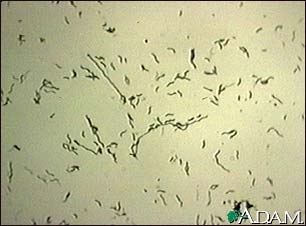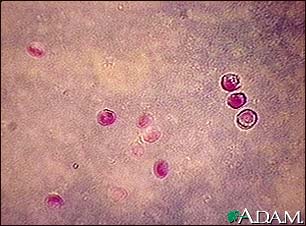Prevention of Diarrhea
- Wash your hands often, especially after going to the bathroom and before eating.
- Teach children to not put objects in their mouth.
- When taking antibiotics, try eating food with Lactobacillus acidophilus, a healthy bacteria. This helps replenish the good bacteria that antibiotics can kill. Yogurt with active or live cultures is a good source of these healthy bacteria.
- Use alcohol-based hand gel frequently.
When traveling to underdeveloped areas, follow the steps below to avoid diarrhea:
- Drink only bottled water and do NOT use ice.
- Do NOT eat uncooked vegetables or fruits that do not have peels.
- Do NOT eat raw shellfish or under cooked meat.
- Do NOT consume dairy products.
 Campylobacter jejuni infection causes cramping, diarrhea, abdominal pain and fever within 2 to 5 days after a person has been exposed to the organism. Campylobacter jejuni is one of the most common bacterial causes of diarrhea. Most cases of Campylobacter jejuni come from handling or ingesting raw or under cooked poultry meat. Although poultry and other birds are not affected by the bacterium, other animals can be. Therefore it is possible for a person to acquire the infection from contact with infected stool of an ill cat or dog. This is what Campylobacter organisms look like through a microscope.
Campylobacter jejuni infection causes cramping, diarrhea, abdominal pain and fever within 2 to 5 days after a person has been exposed to the organism. Campylobacter jejuni is one of the most common bacterial causes of diarrhea. Most cases of Campylobacter jejuni come from handling or ingesting raw or under cooked poultry meat. Although poultry and other birds are not affected by the bacterium, other animals can be. Therefore it is possible for a person to acquire the infection from contact with infected stool of an ill cat or dog. This is what Campylobacter organisms look like through a microscope.
 Cryptosporidium is a protozoan parasite found in contaminated water. It has been increasingly recognized as the cause of outbreaks of diarrhea when water supplies become contaminated. In normal individuals, it is a self-limited disease. Among immunocompromised individuals with AIDS, cryptosporidium can cause severe diarrheal disease, gallbladder disease (cholecystitis), and inflammation of the pancreas (pancreatitis).
Cryptosporidium is a protozoan parasite found in contaminated water. It has been increasingly recognized as the cause of outbreaks of diarrhea when water supplies become contaminated. In normal individuals, it is a self-limited disease. Among immunocompromised individuals with AIDS, cryptosporidium can cause severe diarrheal disease, gallbladder disease (cholecystitis), and inflammation of the pancreas (pancreatitis).
Rotavirus and Severe Childhood Diarrhea
Studies published between 1986 and 1999 indicated that rotavirus causes 22% (range 17%–28%) of childhood diarrhea hospitalizations. From 2000 to 2004, this proportion increased to 39% (range 29%–45%). Application of this proportion to the recent World Health Organization estimates of diarrhea-related childhood deaths gave an estimated 611,000 (range 454,000–705,000) rotavirus-related deaths.
Rotavirus is the leading cause of diarrhea hospitalization among children worldwide. In 2003, we published an estimate of rotavirus-related deaths worldwide based on a review of the literature published from 1986 through 1999 on deaths caused by diarrhea and rotavirus hospitalizations in children. This review indicated that rotavirus accounted for ≈22% of hospitalizations for childhood diarrhea. By applying this fraction to an estimate of 2.1 million annual deaths from diarrhea, we calculated that rotavirus causes 440,000 annual deaths in children <5 years of age worldwide. This estimate was ≈50% of the 1985 estimate of 873,000 rotavirus deaths per year, and the decrease in estimated rotavirus-related deaths paralleled the decrease in deaths from diarrhea of all causes from an estimated 4.6 million deaths in 1982 to 1.6–2.5 million deaths in 2000.
Recent studies suggest that as global deaths from childhood diarrhea decreased during the past 2 decades, the proportion of diarrhea hospitalizations attributable to rotavirus may have increased. For example, prospective, sentinel hospital–based surveillance of rotavirus disease in 9 Asian countries demonstrated a median rotavirus detection of 45% among children hospitalized with diarrhea, a figure that was considerably greater than the detection rates in previous studies from the same countries. Similarly, a more extensive study of 5,768 children hospitalized from 1998 through 2000 in 6 centers in Vietnam identified rotavirus in 56% of patients, a proportion that was more than twice the 21% detection rate reported among children hospitalized with diarrhea in a hospital in Hanoi, Vietnam, from 1981 to 1984.
To systematically evaluate whether these recent reports are isolated observations or reflect a changing trend in the etiology of childhood diarrhea hospitalizations, we reviewed studies of rotavirus detection among children hospitalized with diarrhea published from 2000 through 2004 and compared the data with those of the previous review of studies published from 1986 through 1999.
